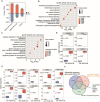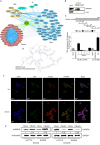LncRNA CRLM1 inhibits apoptosis and promotes metastasis through transcriptional regulation cooperated with hnRNPK in colorectal cancer
- PMID: 35907898
- PMCID: PMC9338583
- DOI: 10.1186/s13578-022-00849-9
LncRNA CRLM1 inhibits apoptosis and promotes metastasis through transcriptional regulation cooperated with hnRNPK in colorectal cancer
Abstract
Background: Colorectal liver metastases (CRLM) continue to have a low survival rate. The number of CRLM regulators and clinical indicators remains limited. Long non-coding RNAs (lncRNAs) are a new master regulator of cell invasion and metastasis. However, the function and regulation mechanism of lncRNAs in colorectal cancer (CRC) metastasis are yet unknown.
Methods: To screen and identify CRLM-related lncRNAs, public transcriptome data were used. Gain and loss of function experiments were carried out to investigate the biological activities of lncRNA CRLM1 in vitro and in vivo. RNA sequencing (RNA-seq), chromatin isolation by RNA purification (ChIRP), immunofluorescence (IF), quantitative real-time PCR (qRT-PCR), western blotting, and rescue experiments were performed to explore the molecular mechanism of CRLM1. Moreover, identified the proteins, DNAs, and RNAs that interact with CRLM1.
Results: The investigation of lncRNA expression dynamics in CRLM, primary CRC, and normal tissues in this work resulted in identifying a series of lncRNAs associated with metastasis, including CRLM1. CRLM1 inhibited apoptosis of CRC cells and promoted liver metastasis in Balb/C nude mice. CRLM1 was weakly associated with the chromatin regions of genes involved in cell adhesion and DNA damage, and this association was bidirectionally correlated with CRLM1-regulated pro-metastatic gene expression. CRLM1 physically interacts with the hnRNPK protein and promotes its nuclear localization. CRLM1 effectively enhances hnRNPK promoter occupancy and co-regulates the expression of a panel of metastatic genes.
Conclusions: The finding of the clinically significant lncRNA CRLM1 in promoting metastasis and regulating gene expression suggests a potential biomarker and target for CRLM therapy.
Keywords: Colorectal cancer; Gene expression; Metastasis; hnRNPK; lncRNA CRLM1.
© 2022. The Author(s).
Conflict of interest statement
The authors have no conflicts of interest to declare.
Figures








Similar articles
-
LncRNA SATB2-AS1 inhibits tumor metastasis and affects the tumor immune cell microenvironment in colorectal cancer by regulating SATB2.Mol Cancer. 2019 Sep 6;18(1):135. doi: 10.1186/s12943-019-1063-6. Mol Cancer. 2019. PMID: 31492160 Free PMC article.
-
Circ-GALNT16 restrains colorectal cancer progression by enhancing the SUMOylation of hnRNPK.J Exp Clin Cancer Res. 2021 Aug 27;40(1):272. doi: 10.1186/s13046-021-02074-7. J Exp Clin Cancer Res. 2021. PMID: 34452628 Free PMC article.
-
Long noncoding RNA kcna3 inhibits the progression of colorectal carcinoma through down-regulating YAP1 expression.Biomed Pharmacother. 2018 Nov;107:382-389. doi: 10.1016/j.biopha.2018.07.118. Epub 2018 Aug 9. Biomed Pharmacother. 2018. PMID: 30099342
-
Aberrant expression of long noncoding RNA SNHG15 correlates with liver metastasis and poor survival in colorectal cancer.J Cell Physiol. 2019 May;234(5):7032-7039. doi: 10.1002/jcp.27456. Epub 2018 Oct 14. J Cell Physiol. 2019. PMID: 30317592
-
LncRNA GAL promotes colorectal cancer liver metastasis through stabilizing GLUT1.Oncogene. 2022 Mar;41(13):1882-1894. doi: 10.1038/s41388-022-02230-z. Epub 2022 Feb 11. Oncogene. 2022. PMID: 35149838
Cited by
-
Heterogeneous nuclear ribonucleoprotein K is a potential target for enhancing the chemosensitivity of nasopharyngeal carcinoma.Open Life Sci. 2024 Oct 30;19(1):20220975. doi: 10.1515/biol-2022-0975. eCollection 2024. Open Life Sci. 2024. PMID: 39479349 Free PMC article.
-
The Emerging Role of Long Noncoding RNAs in Sorafenib Resistance Within Hepatocellular Carcinoma.Cancers (Basel). 2024 Nov 21;16(23):3904. doi: 10.3390/cancers16233904. Cancers (Basel). 2024. PMID: 39682093 Free PMC article. Review.
-
Crosstalk between non-coding RNAs and programmed cell death in colorectal cancer: implications for targeted therapy.Epigenetics Chromatin. 2025 Jan 15;18(1):3. doi: 10.1186/s13072-024-00560-8. Epigenetics Chromatin. 2025. PMID: 39810224 Free PMC article. Review.
-
Prognosis and Novel Drug Targets for Key lncRNAs of Epigenetic Modification in Colorectal Cancer.Mediators Inflamm. 2023 Apr 12;2023:6632205. doi: 10.1155/2023/6632205. eCollection 2023. Mediators Inflamm. 2023. PMID: 37091904 Free PMC article.
-
Diagnostic and prognostic role of LINC01767 in hepatocellular carcinoma.World J Hepatol. 2024 Jun 27;16(6):932-950. doi: 10.4254/wjh.v16.i6.932. World J Hepatol. 2024. PMID: 38948436 Free PMC article.
References
Grants and funding
LinkOut - more resources
Full Text Sources
Molecular Biology Databases
Miscellaneous

